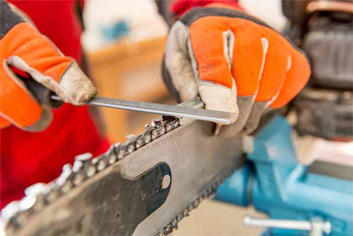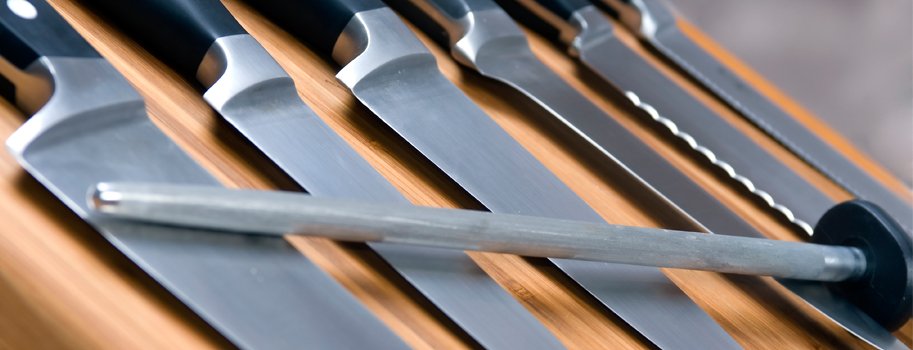A singing saw, or musical saw, is a saw whose purpose is to make music. It was popular in vaudeville and in folk music in the U.S. and Russia.
Did you know that knives come with many different angled edges, with the steel in varying degrees of hardness? Each knife requires an individualized approach to ensure that it is sharpened for optimal performance.
To operate at maximum efficiency a saw blade should be cleaned on a regular basis and the blade professionally sharpened proportionate to this. In other words, about every 2 to 3 cleanings (when your blade leaves burn marks or tear-outs) your blade should also be sharpened.
When working with dull knives, more pressure is needed to cut food. This often leads to the food looking jagged or crushed, especially with fragile foods such as herbs and tomatoes. Sharp knives require less force and provide a clean cut.
When you have your tools sharpened, you can also request a coating service as well. They can apply or reapply a wide range of coatings after sharpening the blade, depending on the type of application the tool is being used for.
Although a sharp knife is safer to use than a dull knife, it can still be dangerous if you don’t utilize proper cutting technique. Be sure to tuck your fingers away and use your knuckles to guide the knife to avoid cutting yourself.
One of the quickest ways to dull a cutting tool is to use it for applications it was not designed to perform. Make sure the cutting tool is at least as hard as the material being machined; have dulled tools sharpened and recoated.
It’s important to remember that a dull kitchen knife is often a dangerous kitchen knife. Since dull knives require more pressure to cut through even relatively soft foods, you may be more at risk for slips that can cause cuts.
How often your saw blade should be sharpened depends on a number of factors, including: the types of wood you cut into, how often you use your saw, how much heat is generated during your cutting sessions, and the quality of the carbide.
There are several ways to check to see if your knife needs sharpening. If you can actually see the edge of the blade, it's probably time to have it sharpened. A really sharp knife edge is too thin to see easily.
No matter how closely you monitor your tools, sometimes they need to be sharpened. Why? “A tool knows exactly how it is meant to be handled, while the user of the tool can only have an approximate idea.” (Milan Kundera)
Did you know that sharpened knives should seldom, if ever, be stored in a leather sheath? Metallic parts of the knife may react with the leather, staining or even rusting the blade. In fact, brass, nickel, horn, bone, and even ivory or plastic can all cause a reaction with leather.
Modern tooling and resurfacing uses precision CNC machines to ensure a perfect edge. Like most technology, this is constantly evolving, and a tool expert will make sure to keep on top of all of the latest developments and methods to give you the best possible cutting tool.
Quality knives actually fold their edges when they wear down, rather than dull. The metal can be folded back into place in the sharpening process. Sharpening your knives on a regular basis will prolong their life.
Sharpening stones or whetstones have been traditionally used to sharpen the edges of steel tools. These stones can be flat or shaped, and contain natural or man-made materials and grits. Scythes, scissors, chisels, and hand scrapers can all be sharpened by one of these stones.
Did you know knife-like tools are over two and half million years old? The first evidence of these sharp tools are those of the Oldowan tools that were found by Louis Leakey in the Olduvai Gorge in Tanzania.
When drilling extremely small holes, it is vital that the drill point be sharp, otherwise it is likely to break. If drilling has become more difficult, have the drill sharpened to its original specifications to prevent breakage and a loss of productivity.
While filing the teeth of a saw blade, it’s important to secure it tightly in order to ensure even filing. Once you have leveled the blade on the vise in a right manner, start filing the teeth slowly and steadily.
Did you know that the first knife was made approximately 2 million years ago from pieces of flint, obsidian, and rock? Our ancestors made these tools and were roughly the size of an adult's fist.
Corner rounding cutters, used when a radius is needed on a part, require a two-step sharpening process. First, the insides of the flutes must be properly faced for the sharpest cutting surface. Once completed, it may be necessary to adjust the radius.
If your saw is cutting at a much slower pace than usual, this may be telling you in needs to be sharpened. A professional saw sharpening service is your best bet for restoring your saw to its prior operating capacity.
A knife with a Japanese blade can almost be considered talon shaped. Japanese knives have a straight edge that is level with the spine, which in turn curves down gradually to meet the edge of the blade.
Many modern cutting tools are custom made so they can make multiple cuts at once. These tools can present a much trickier process for regrinding, but you don’t have to worry. A tool expert is more than up for the task.
Have you heard of doing "wheelies" with your kitchen knife? It's a safer way to cut. Instead of lifting the blade tip, keep it on the cutting board and cut by lifting and lowering the handle of the knife in an arching motion.





